
Diary of a 21st century
public commission project
Véronique Joumard
Creation of original contemporary stained-glass windows in the transept of the Cathedral of Notre-Dame in Bayeux, a work conceived at the request of regional direction of cultural affairs in Normandy as part and with the support of the public commissions programme of the Ministry of Culture.
2013 Paris
My first instinct for the new stained-glass windows in Bayeux Cathedral was to use glass prisms. I wanted prisms that would refract the light in multicolored projections throughout the interior of the cathedral, while retaining the intensity of light that penetrated each window into the very heart of the cathedral.

Swarovski crystal prism
2013 Bayeux
The colors for each bay window were chosen according to its geographic orientation: the northside windows are composed of a cooler range of lights, and warmer on the southside. Windows facing east, which are lit up in the morning, are clearer than those to the west, where the sun sets.


Sunshine test

Map of Bayeux cathedral and indication dichroic glasses colors seen from the inside (on a white background) and from the outside (on a black background), on day light • Dichroic lenses viewed from the front and from the inside, and from the outside for the racks 115-113 • Preparatory drawing, bay 120-122 • Bay 116 simulation, southeast side, exterior view
2013 Bayeux
The prisms are actually faceted crystals made of dichroic glass in the shape of triangles or trapezoids, each corresponding to the shape of the window tracery under each tympanum, whether polylobes. Depending on the angle of view and the exterior light, this type of glass can reflect a transmitted light into different colors inside as well as outside the cathedral.

Bay 113 simulation, northeast side, interior view
2014 Munich
The colors chosen for the bay windows, the type of glass in which the crystals were inserted, and the technical problems in mounting them were designed during many visits of close collaboration with the glass workshop of Franz Mayer & Co, in Munich.

Hand-blown antique glasses samples

Dichroic glasses color test and first full-size trial
2014 Palaiseau
The crystals were conceived and designed with the Institute d’Optique Graduate School, Paris-Saclay. Each one took into account the characteristics and placement of each window, its height, and orientation to the sunlight.

Prism rough drawing by Guillaume Graciani


Opaque resin 3D printt
2014 Munich
Along with the optical properties of each crystal, the shape and volume of each was calculated to produce a burst of color on a scale with the grandeur of the cathedral’s windows.

Crystal prism prototype

Fixing test on a full-size tile of a 3D resin prism
2014 Bayeux
Tests made inside the cathedral helped to refine the technical and aesthetic decisions. It was important to verify, on site, how the crystals and the colored glass would react to the particular light entering the cathedral.


First crystal prism tests, Bayeux Cathedral
2014 Bayeux
By using lead tracing, the crystal prisms were set in hand-blown antique glass. Each was installed at the crossing of two implied lines, one vertical and one horizontal, but situated at different places in each bay window, in an almost musical composition.

Installation by Atelier Mayer of several tiles, selection of antique blown glasses and dichroics
2014 Bayeux
A test window was installed in October 2014 by the Franz Mayer & Co glassworks. This made it possible to specify the characteristics necessary for the antique hand-blown glass in which the crystals would be set along with the mounting techniques necessary for each.

Test bay (bay 114)
(photo Maxence Le Vaillant)
2014 Bayeux
The shape and the techniques necessary for inserting each crystal prism led to the general design of each window. The clear parts, made of antique blown glass, determined the transparency and created a link between the upper and lower parts of each bay window.

Exterior view, trefoil with dichroic panes of glass
(photo Maxence Le Vaillant)

Detail, crystal prism and ancient glass
(photo Huz & Bosshard)
2018 Saint-Just
The antique glass panes in which the crystal prisms were set were hand-blown at the Saint-Just glassworks in the Loire Valley. Each plate was made to visibly reveal its hand-manufacture, which contrasts with the industrially made crystal prisms.


Tests for the production of antique blown glasses
2018 Saint-Just
First, manually blown glass is made and split vertically, then flattened in the oven to form the panes that will surround the prisms, which are then manually set into the lower parts of the stained glass windows.
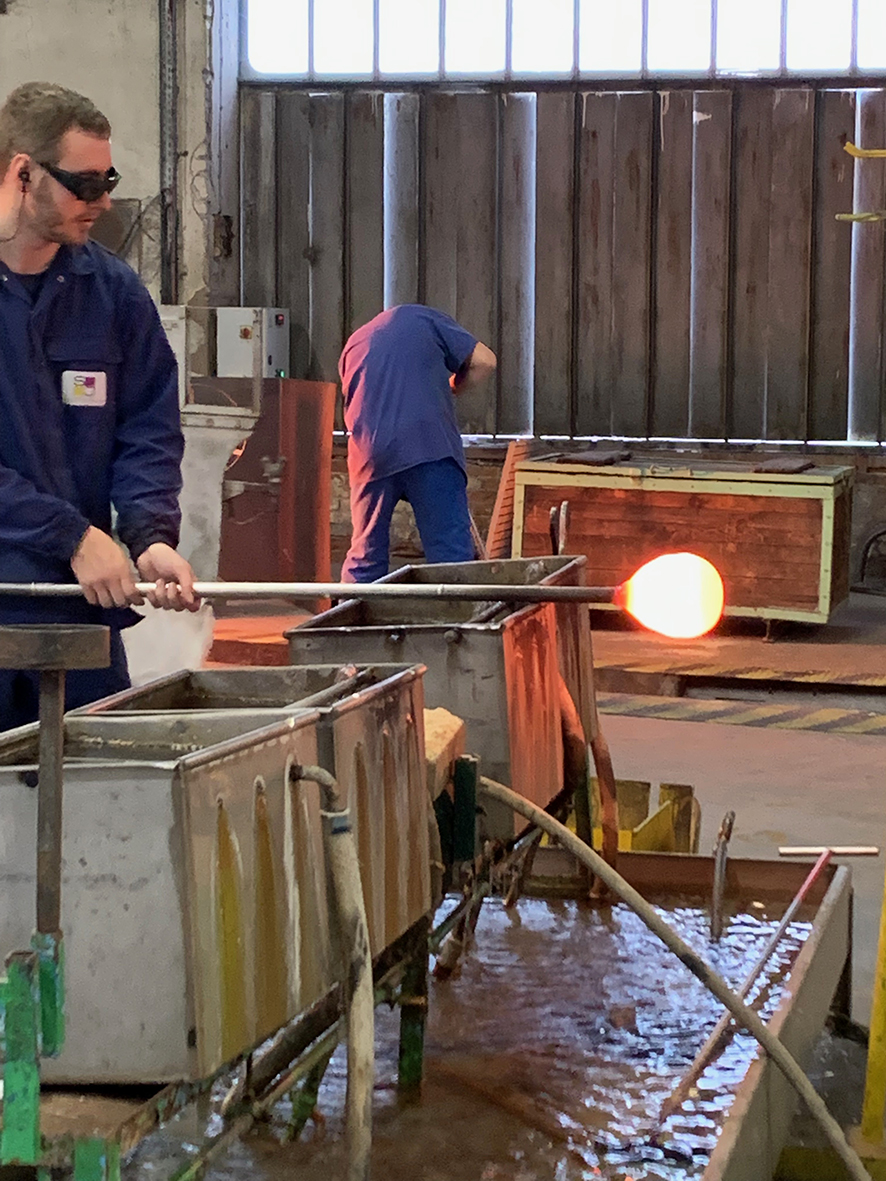
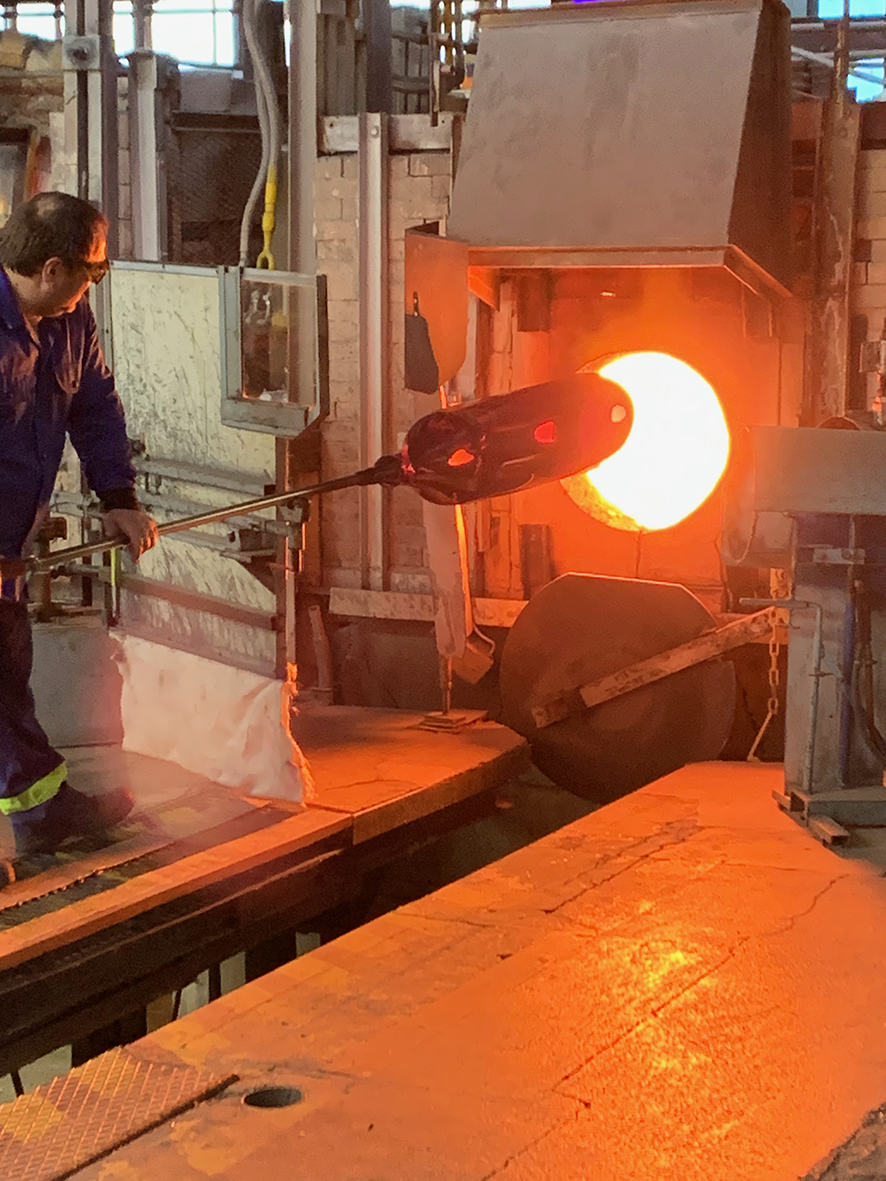
Saint Just Glassworks
Creation of mouth-blown glass
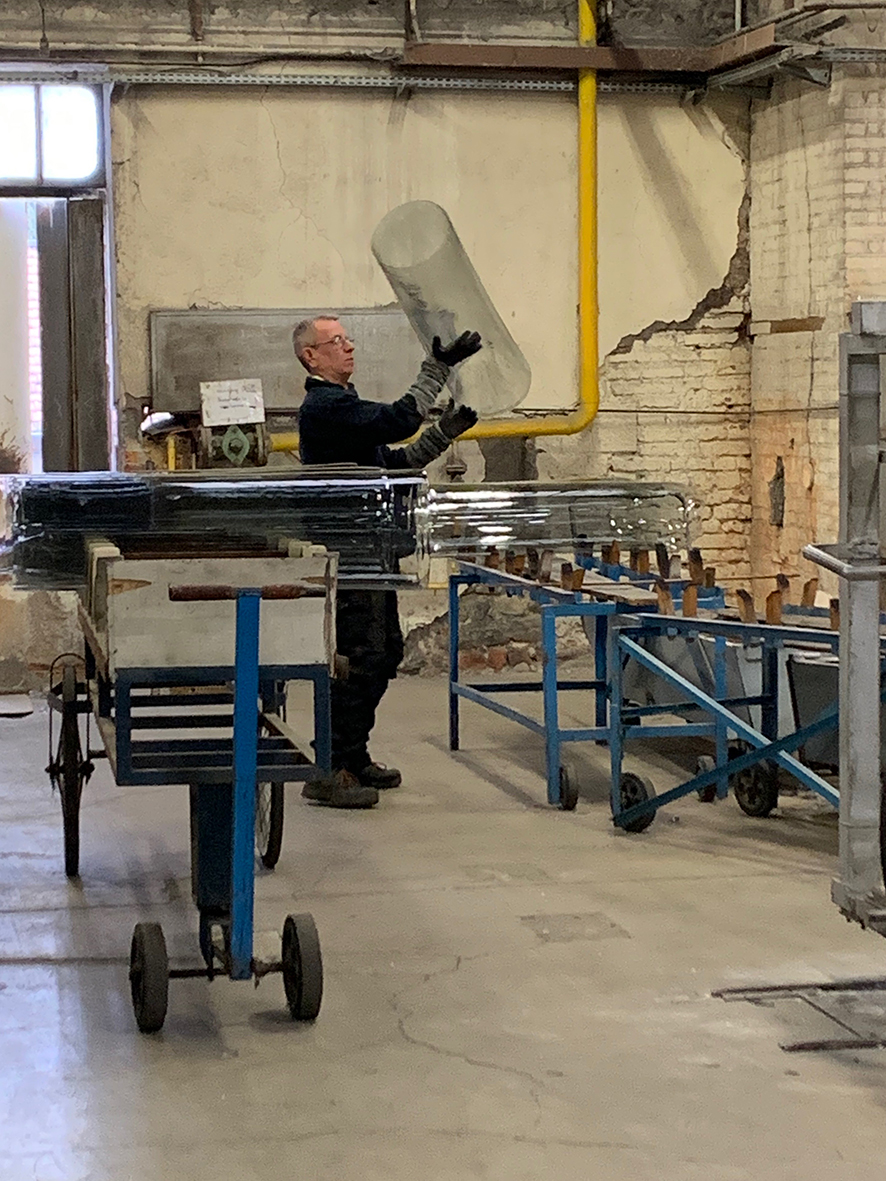
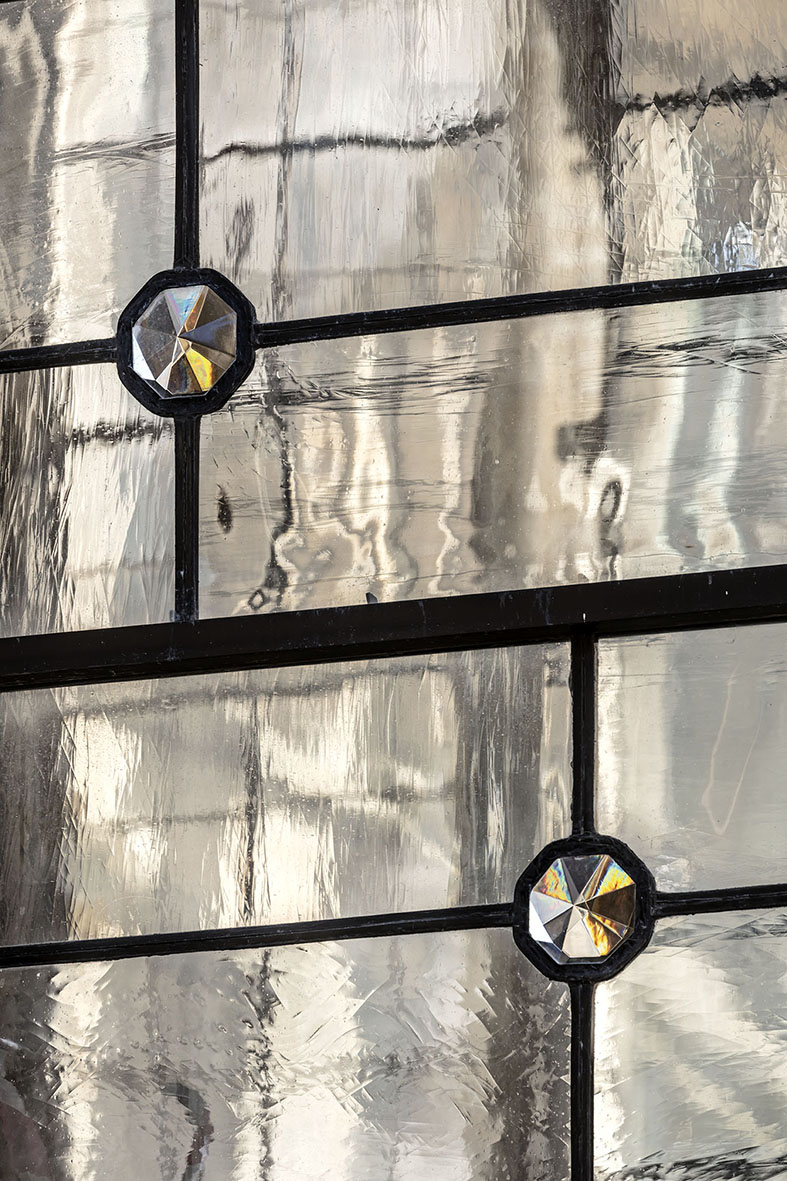
Saint Just Glassworks
Creation of mouth-blown glass
Detail of glass panes (photo Luc Boegly)
2018 Cellette
The prisms were cut one by one by Ludovic Sauvètre from a single block of optical glass.
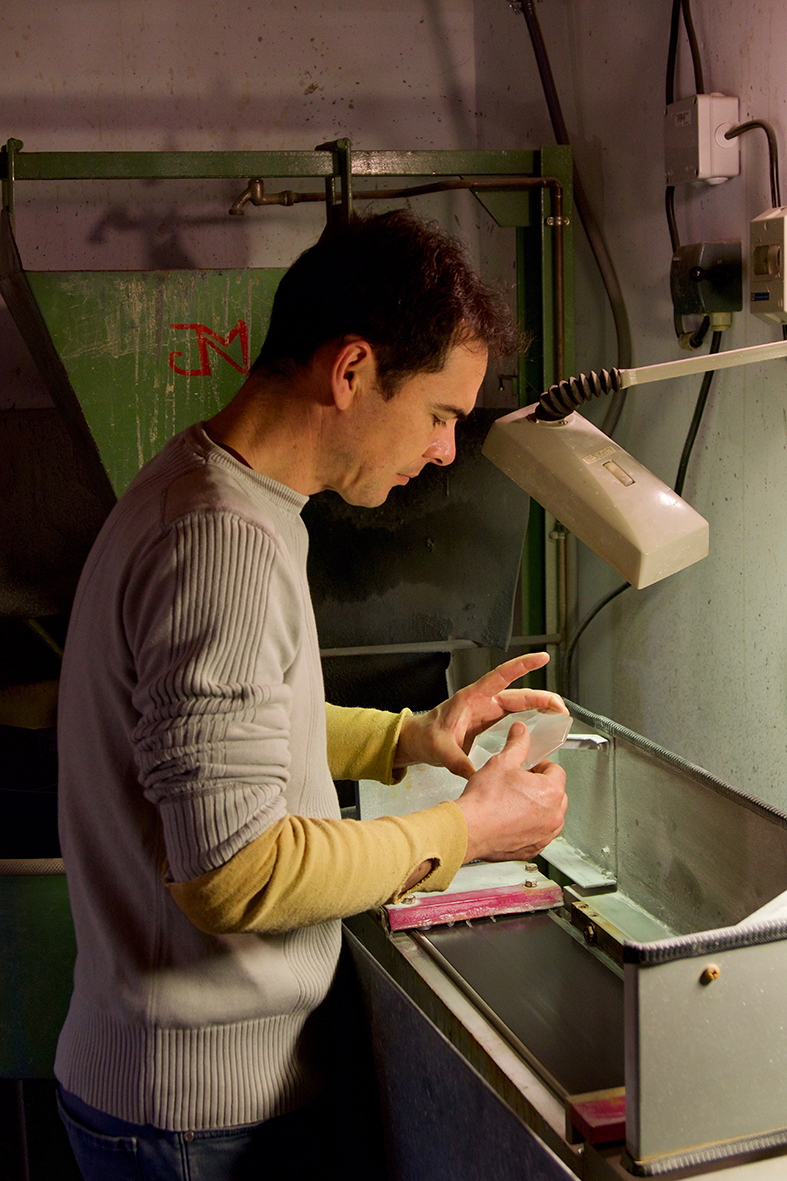
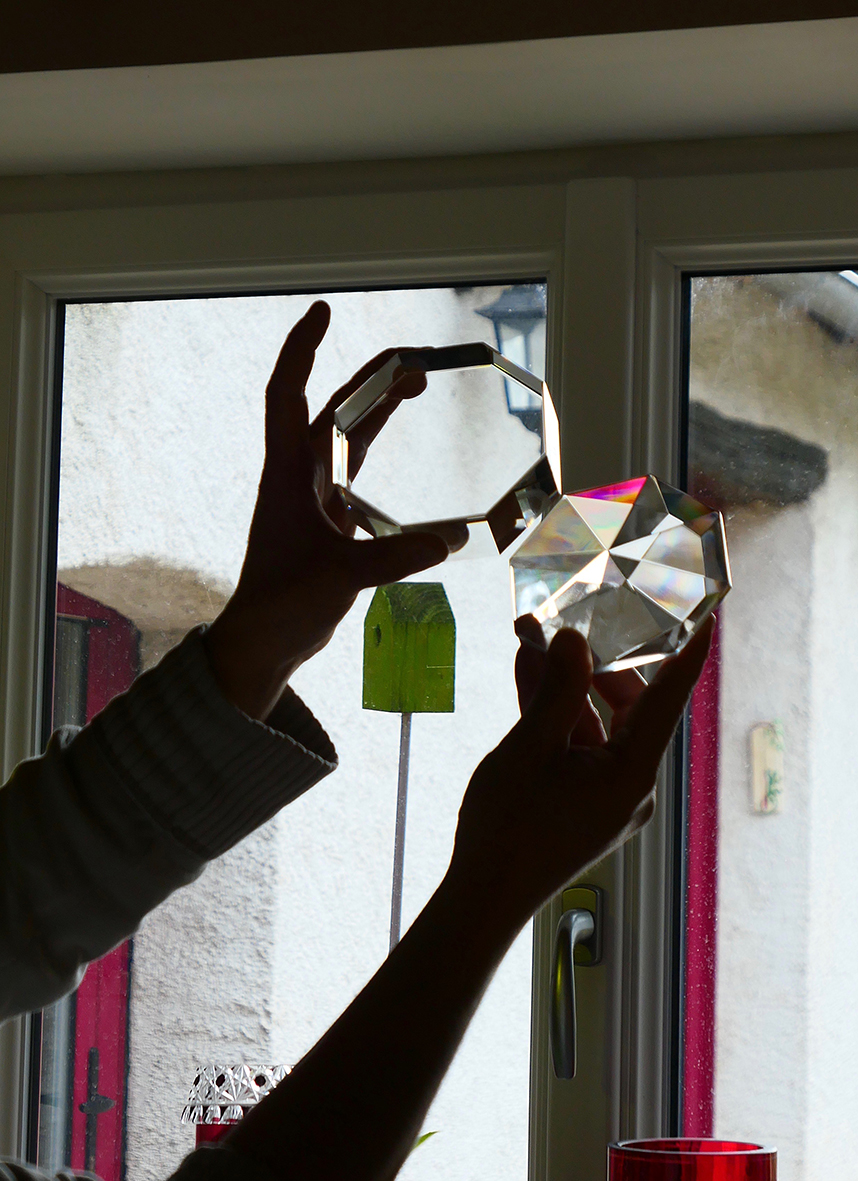
Sizing the glass prisms at the Ludovic Sauvètre workshop
2019 Bayeux
In 2019, work began on bays 120 and 122, which face southwest. It took several months on site for the stone masons to cut and stack the window stones.


Installation of cut stones networks for the masonry recontruction, bays 120 and 122, Entreprise Lefèvre
2019 Le Mans
In Le Mans, the different elements of the two bays were prepared. There, in collaboration with the Vitrail France glassworks, the technical constraints of the stained glass were worked out and assembled in accordance with the spirit of the project.

Tiles preparation for the bays 119-120 installation

Scale 1 printing of the preparatory drawing for bay 122
2019 Le Mans
The upper parts of windows 120 and 122 are made up of more than 170 pieces of colored dichroic and antique hand-blown glass.

Preparation of bay 120 elements
2019 Le Mans
Dichroic glass is made by fusing a glass surface with different metals (aluminum, chrome, magnesium, silicon, titanium, or zirconium), which creates varieties of reflective colors, depending on the angle of view. The method was developed by NASA for satellites to withstand high temperatures. Each piece of dichroic glass was also assembled and reinforced at Vitrail France glassworks.

Preparation of bay 122 elements
2019 Bayeux
The technical aspect and quality of dichroic glass allows it to interact with daylight, while also extending the color effects normally seen only at night.

Trilobe dichroic glasses installation, bay 122, outside view
2020 Bayeux
The colors and the effects of the crystal prism change with the weather and with the light, depending on where they are seen from. Visitors at the Bayeux cathedral might also benefit from the nuances typical of the Normandy sky.

Rainbow inside the Cathedral
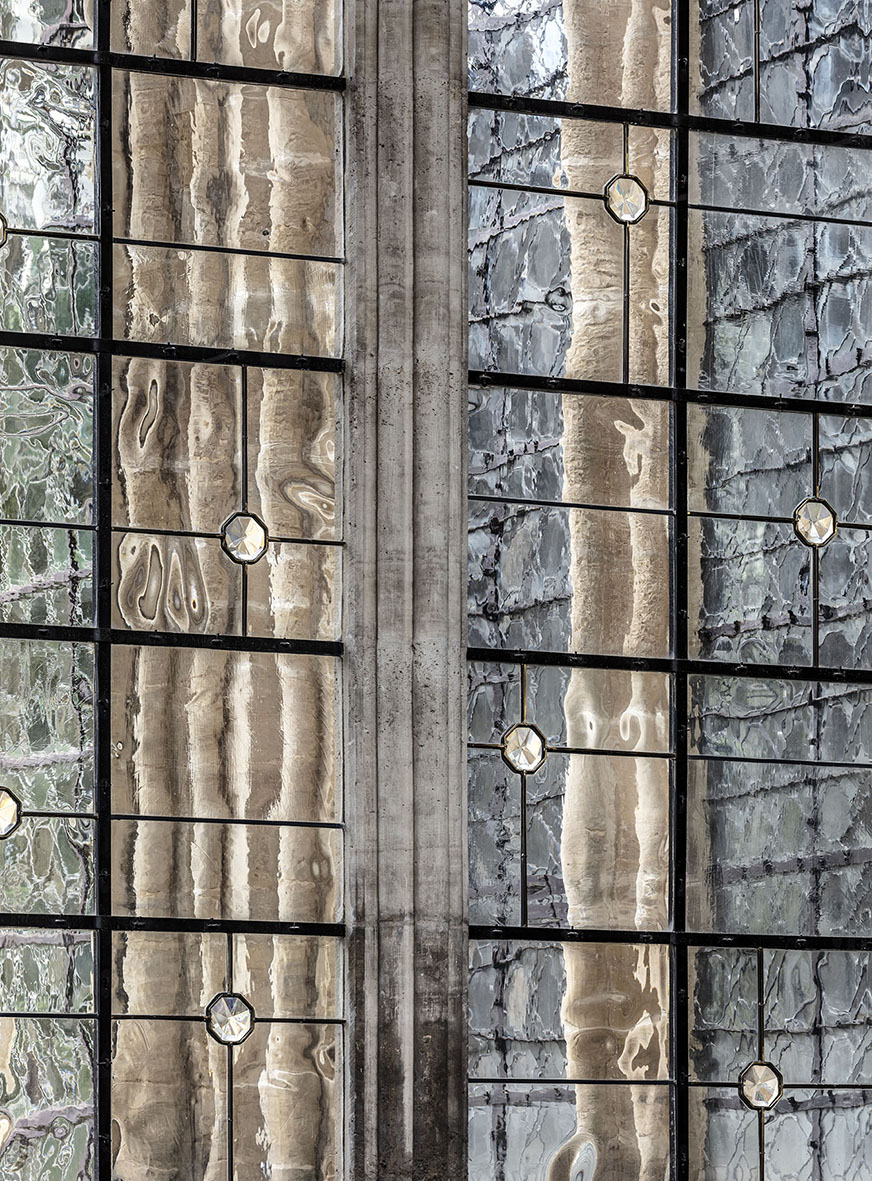
Glass panes with prism tracery, bay 120
(photo by Luc Boegly)
2020 Bayeux
Of the eight bay windows on both sides of the transept, two were installed in 2019. The large, nineteenth bay at the south end will be completely restored in 2020. One year’s work is required for the stonework and the glass for each side. The finished work is expected to take until 2024.

Bay windows 120, from outside
(photo Maxence Le Vaillant)

Bay windows 120-122, interior view
(photo Maxence Le Vaillant)
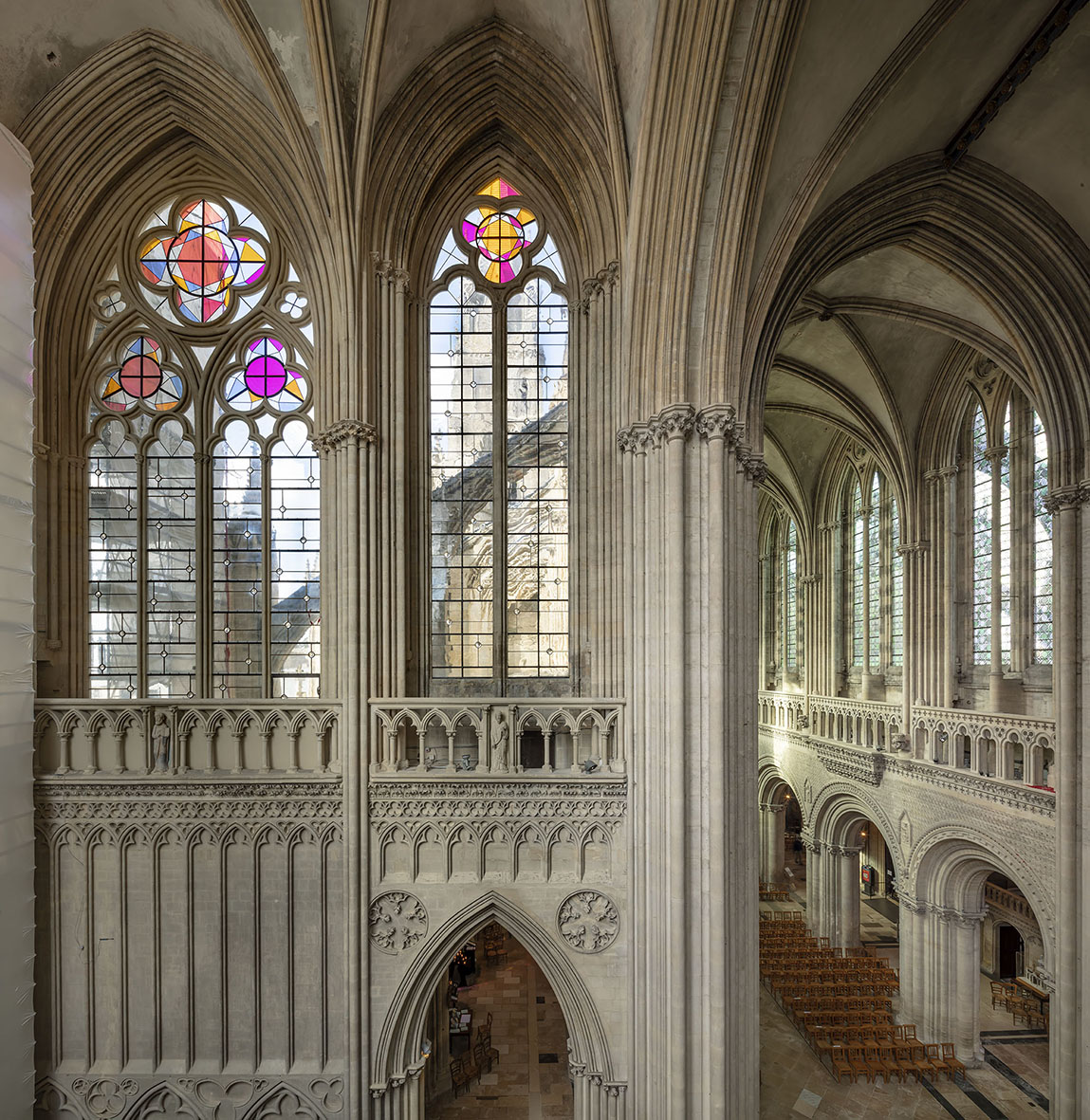
Interior views of bays 120 and 122
(photo Luc Boegly)

Rainbow inside the Cathedral

Bay colors 120-122 to bay 114

120-122 bay windows, from outside
(photo Bruno Glasberg)
2020 Bayeux
In 2014, the art historian Michel Gauthier wrote an essay about the project, entitled, Shards in Stained-glass. It is available here.
2021 Bayeux
In 2021, construction of the masonry and installation of the stained-glass began on the southeast side. During the day, splashes of colors would be reflected onto the white tarp that covered the scaffolding.
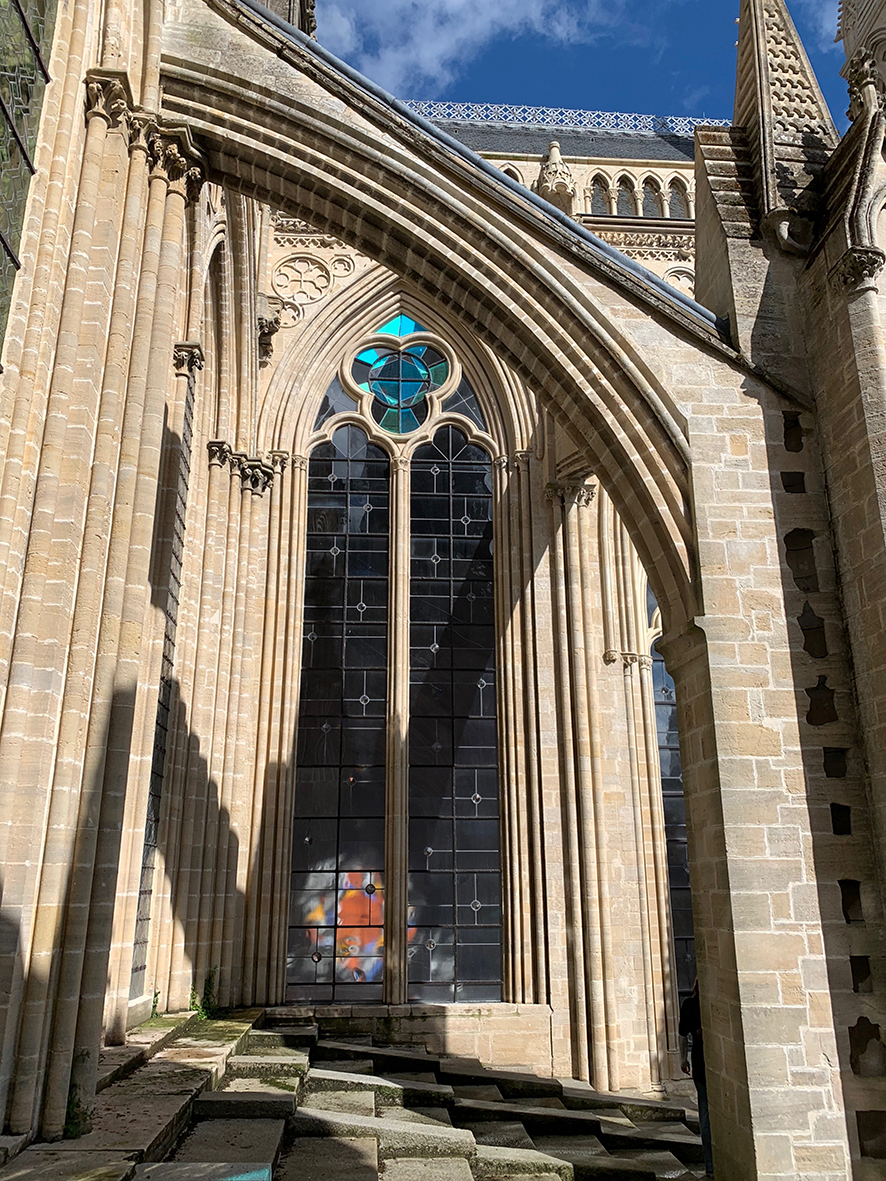
Bay 120, with colors projected through the stained-glass windows in the interior, southeast side
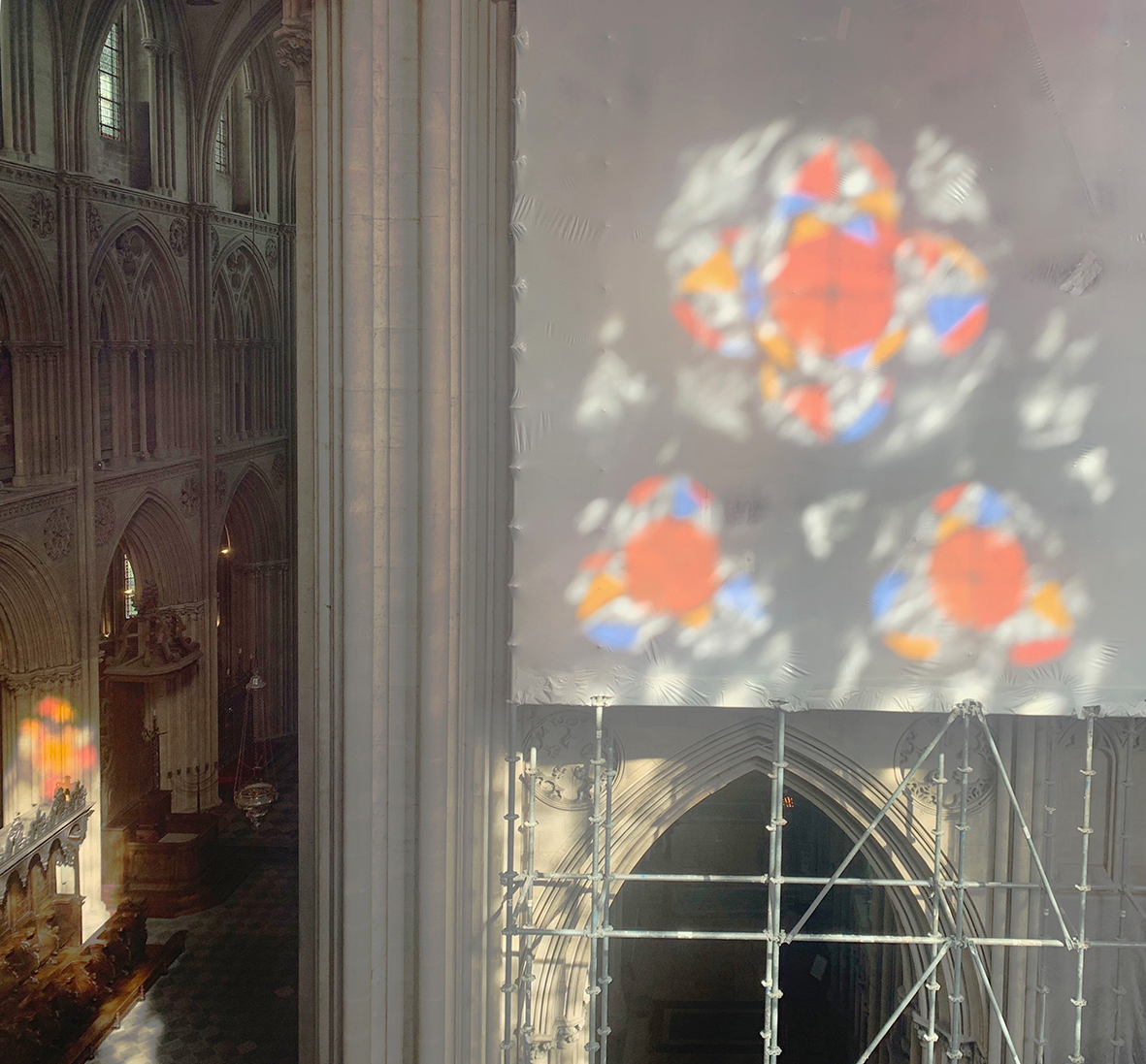
Bay 122, colors projected through the stained glass windows onto the scaffolding tarp, southeast side
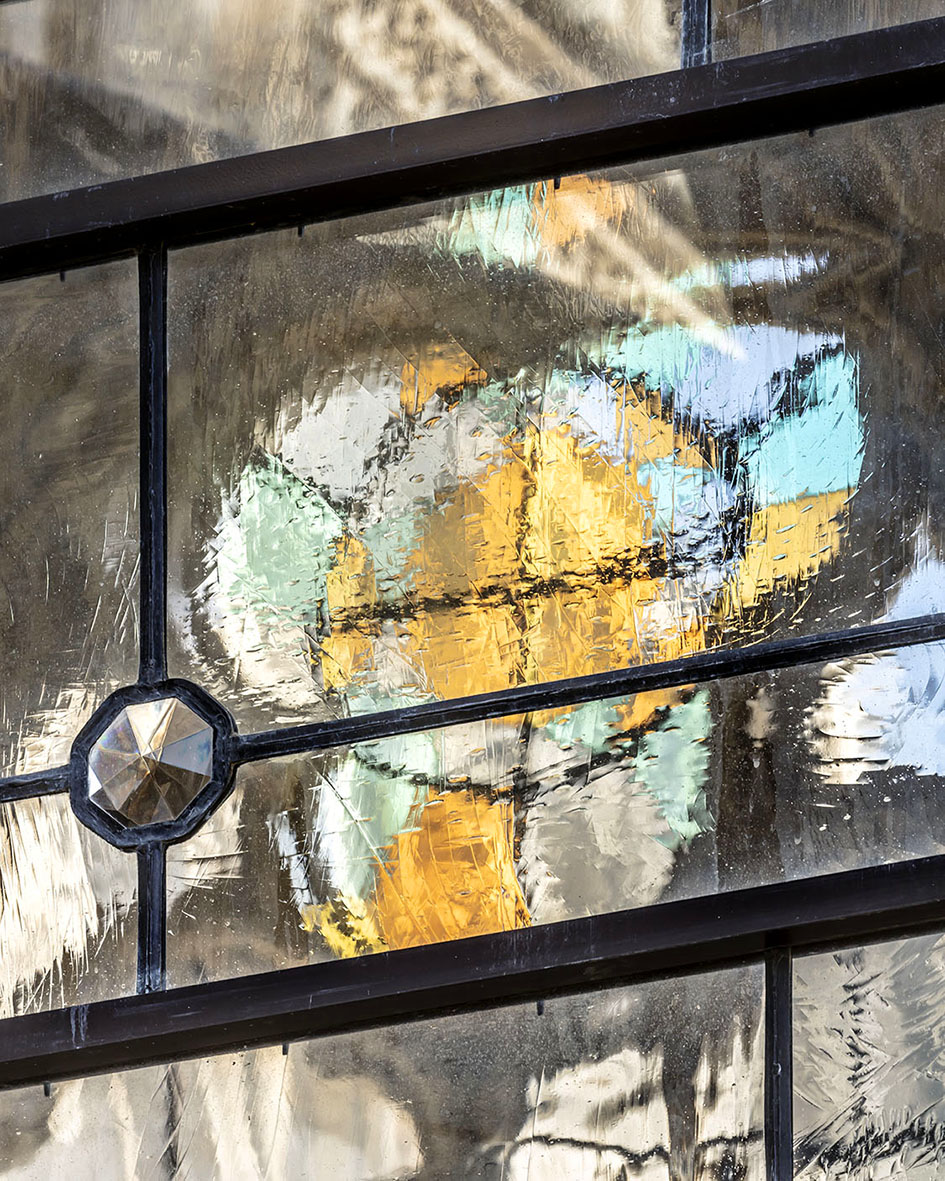
Trilobe of stained glass seen through the blown glass windows
2022 Bayeux
In the beginning of 2022, when the two Southeast bays were exposed, the color from the new stained glass windows could be seen from the intersection outside the cathedral.
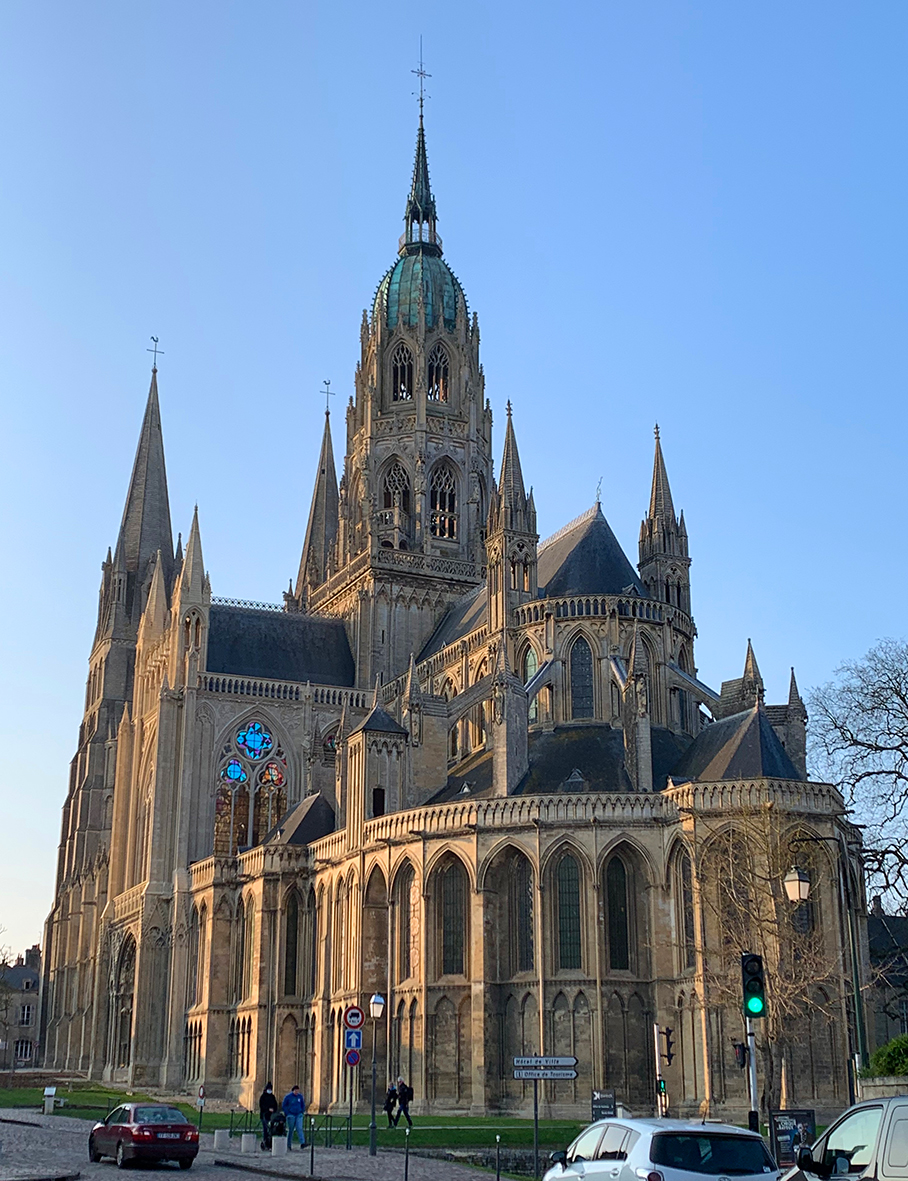
Exterior view of bays 114 and 116, from the intersection of rue Larcher and rue Lambert-Léonard Le Forestier
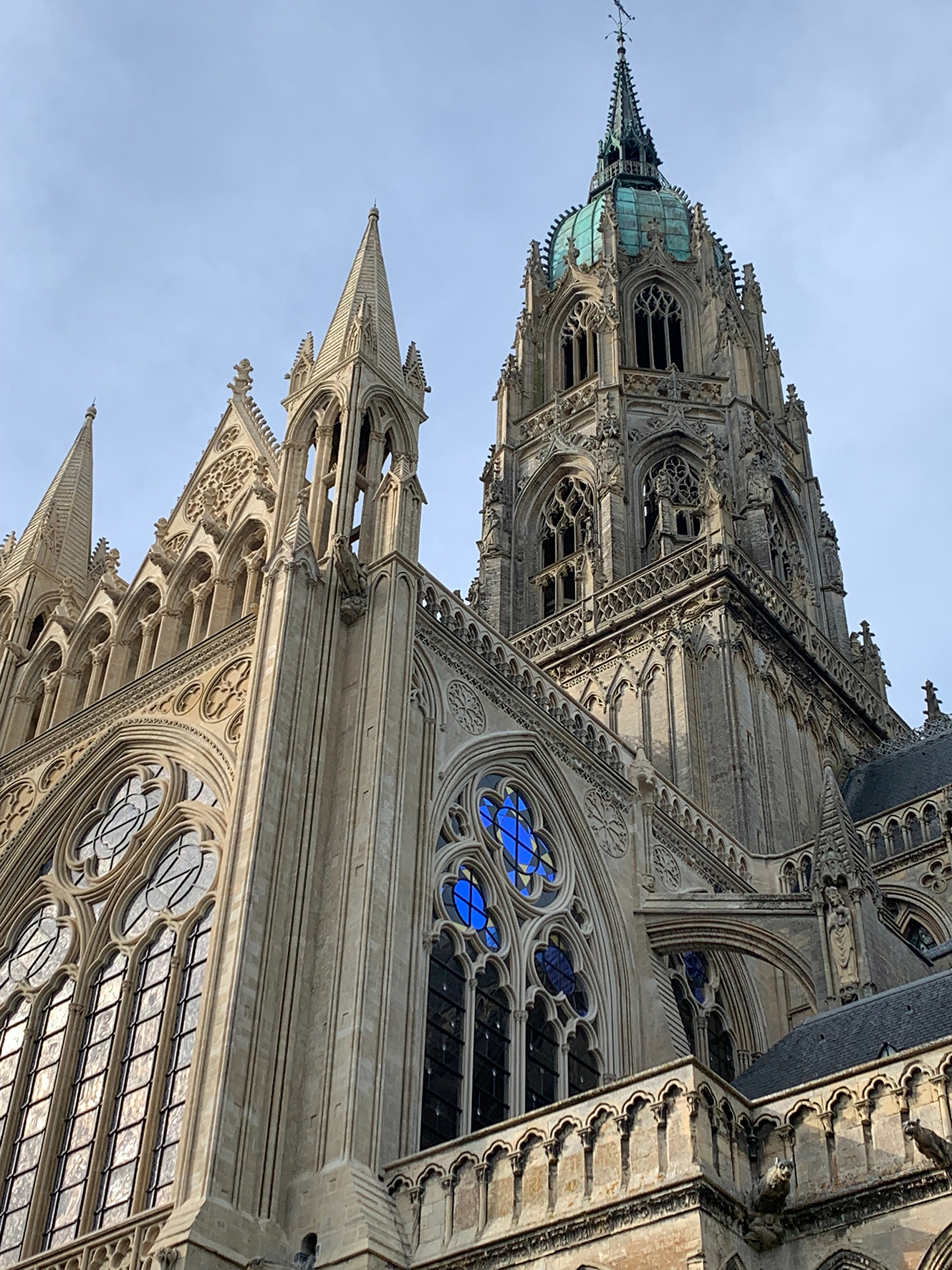
Exterior view of bays 114 and 116, from rue Lambert-Léonard Le Forestier
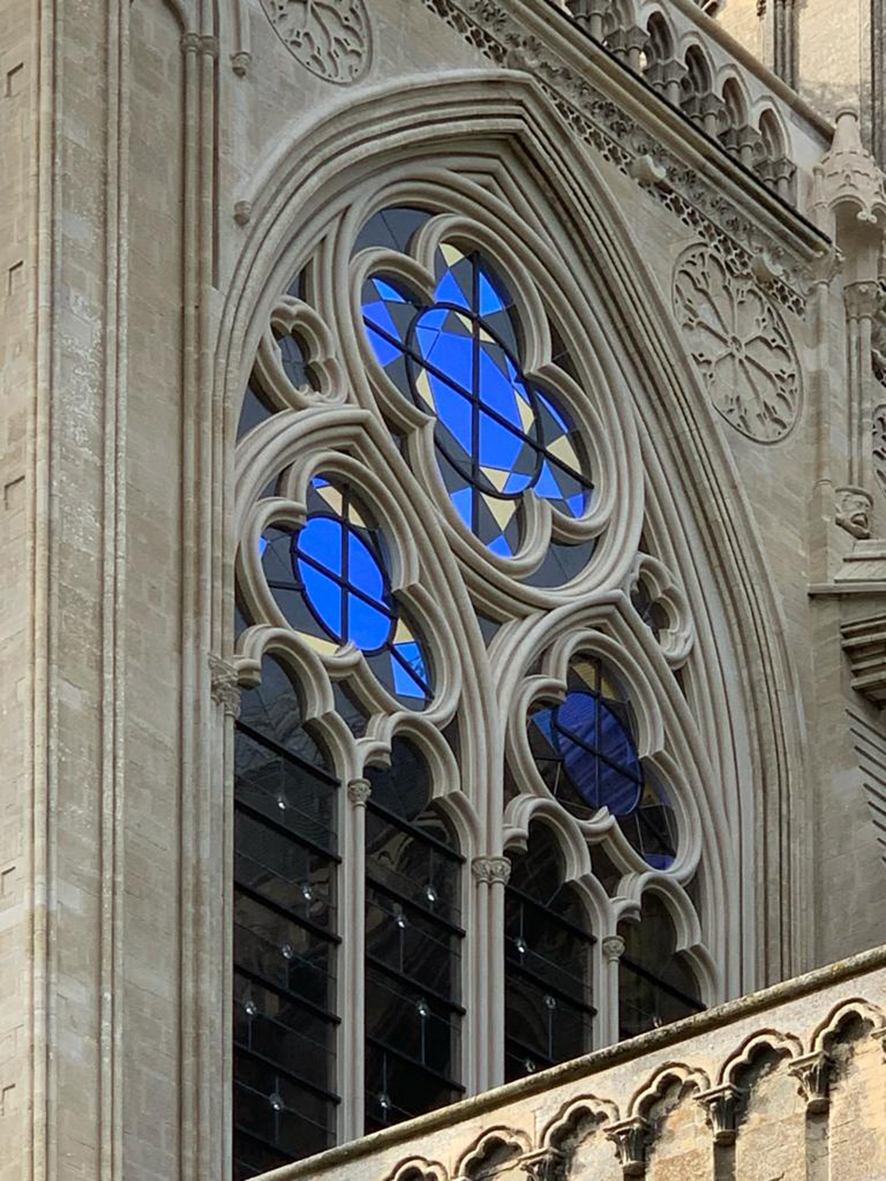
Exterior view of bay 116, from rue Lambert-Léonard Le Forestier
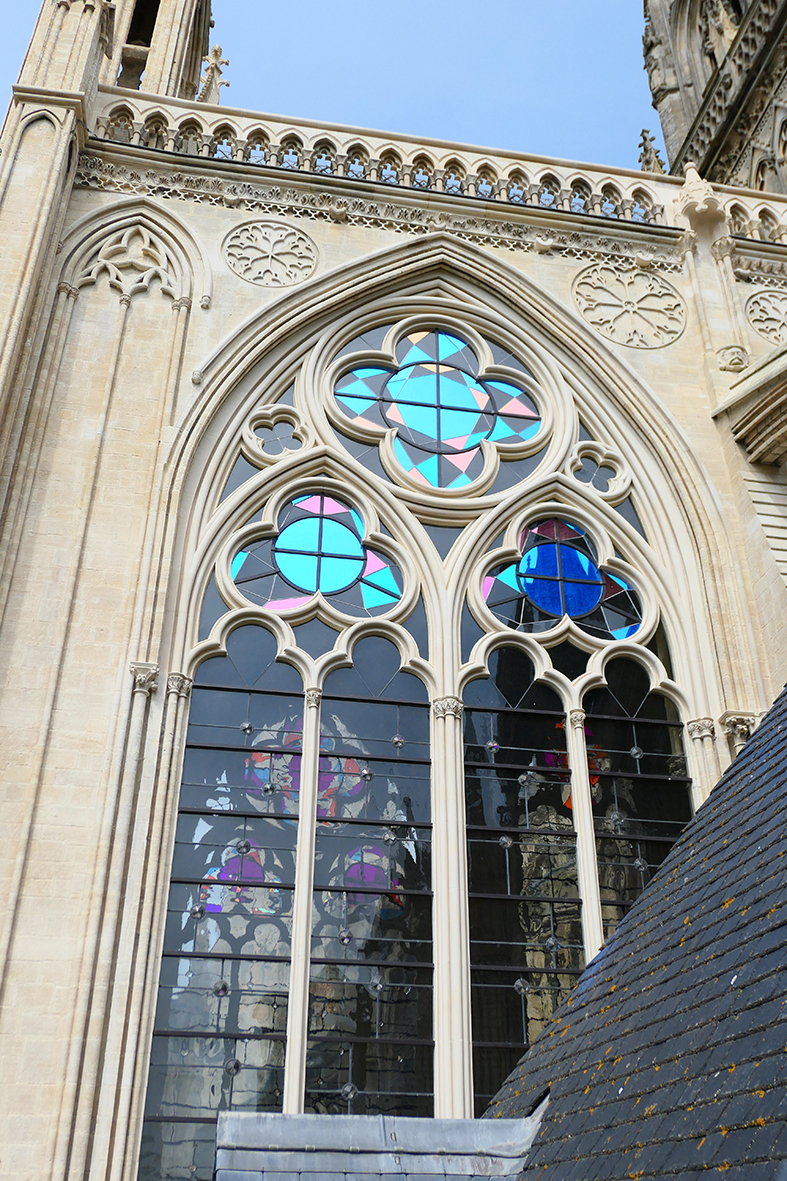
Bay 116
2022 Bayeux
Throughout the day, the four facing southwest and southeast bays reflect colors and the interior walls come alive in a radiantly colored dialogue between them.
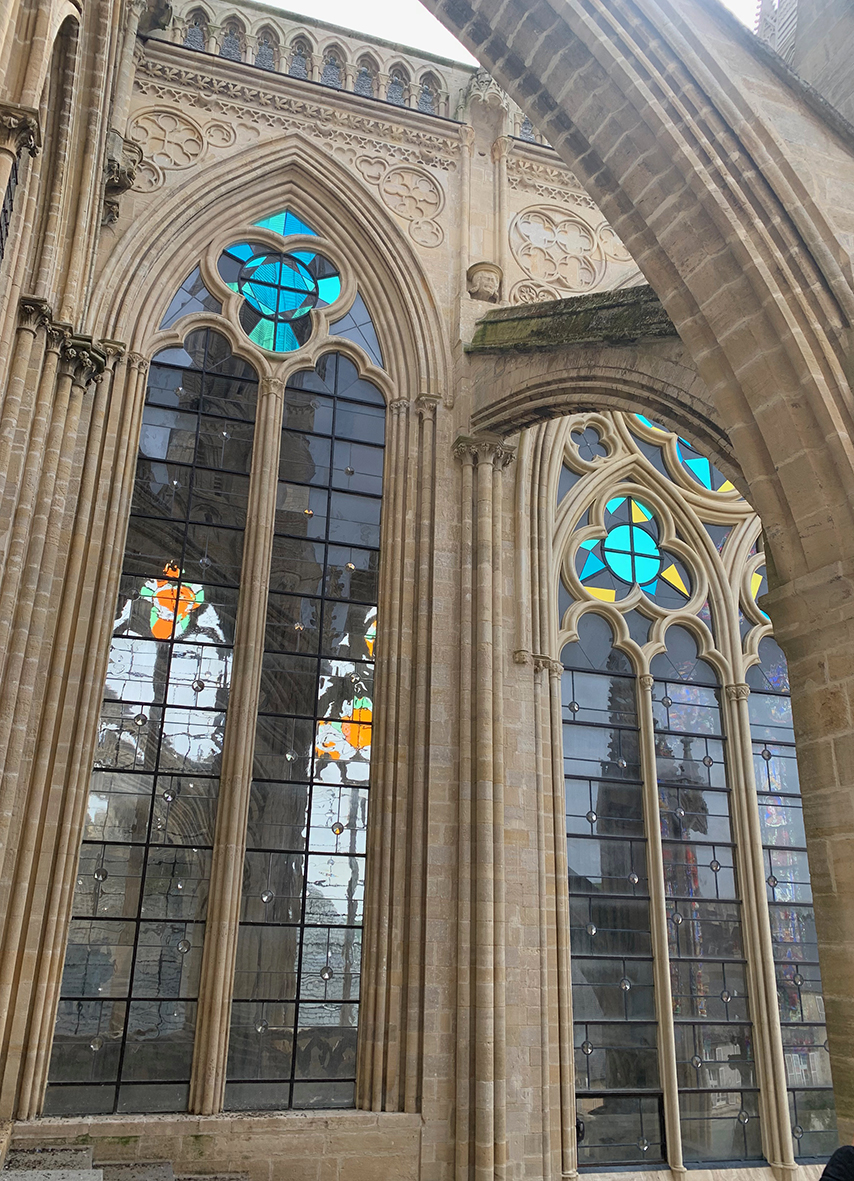
Exterior view of bays 120 and 122, in transparecy bays 114 and 116
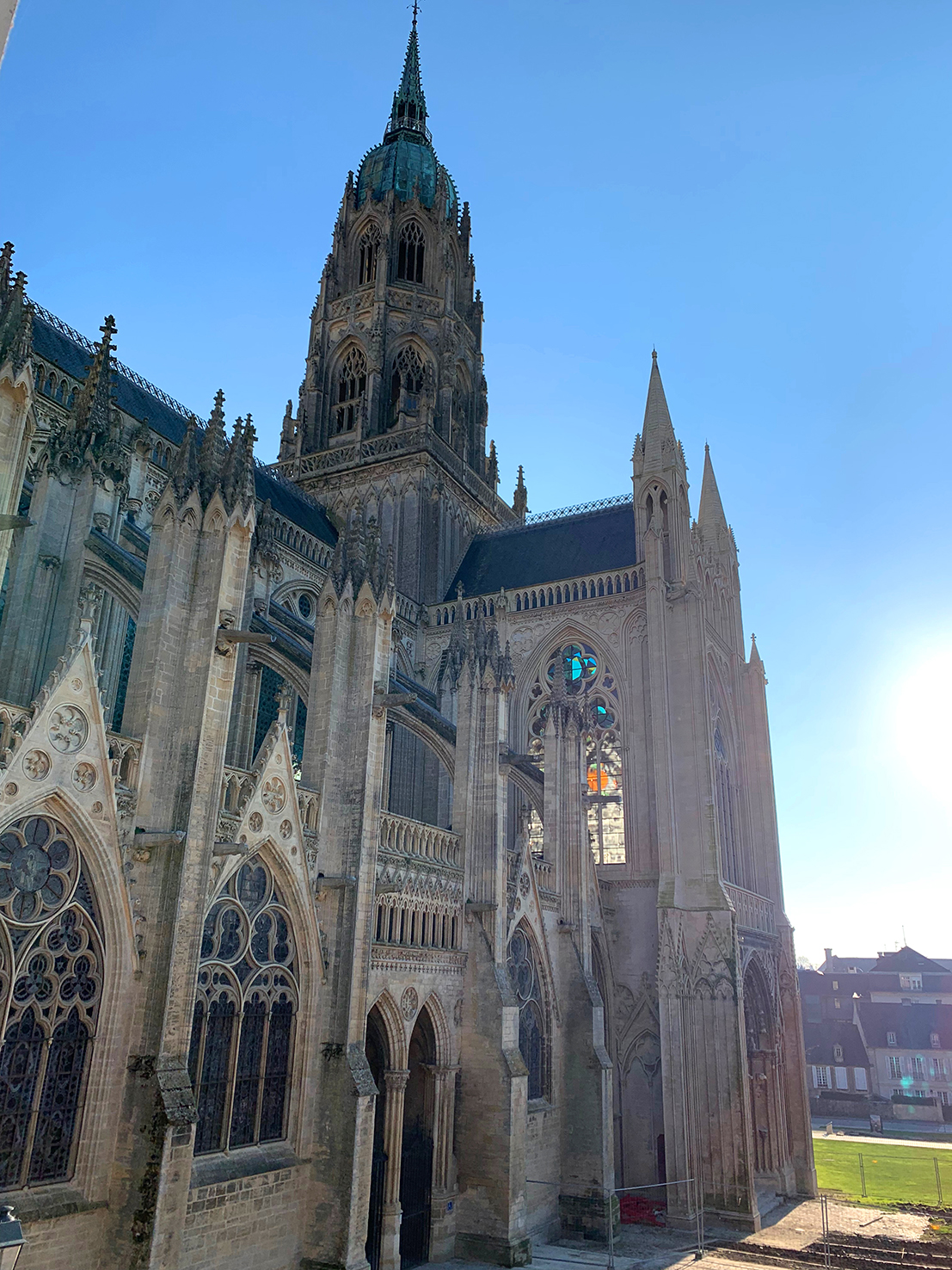
Early morning view of exterior view of bay and 122, with interior view of bay 116
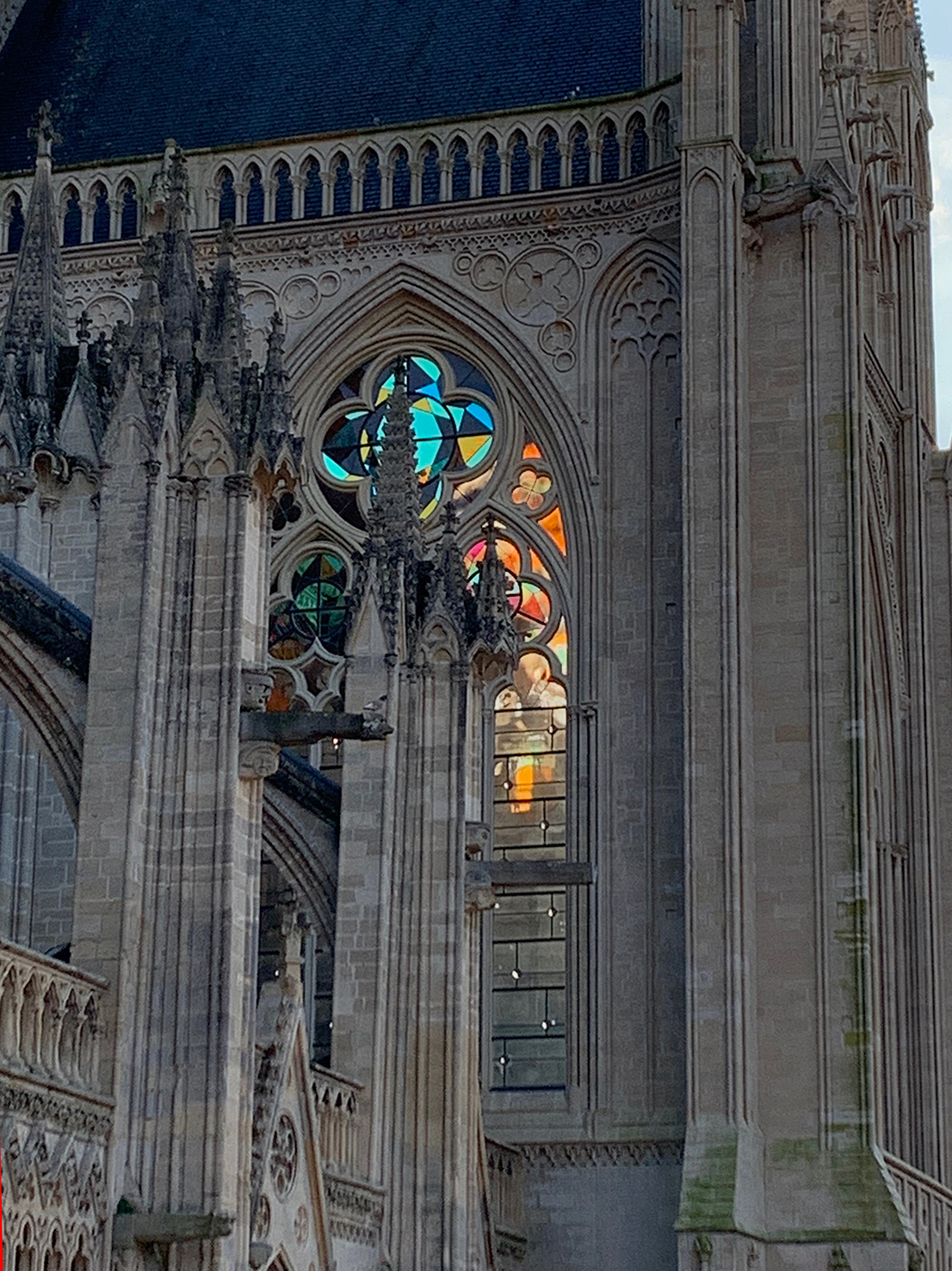
Early morning view of exterior view of bay 120, with interior view of bays 116
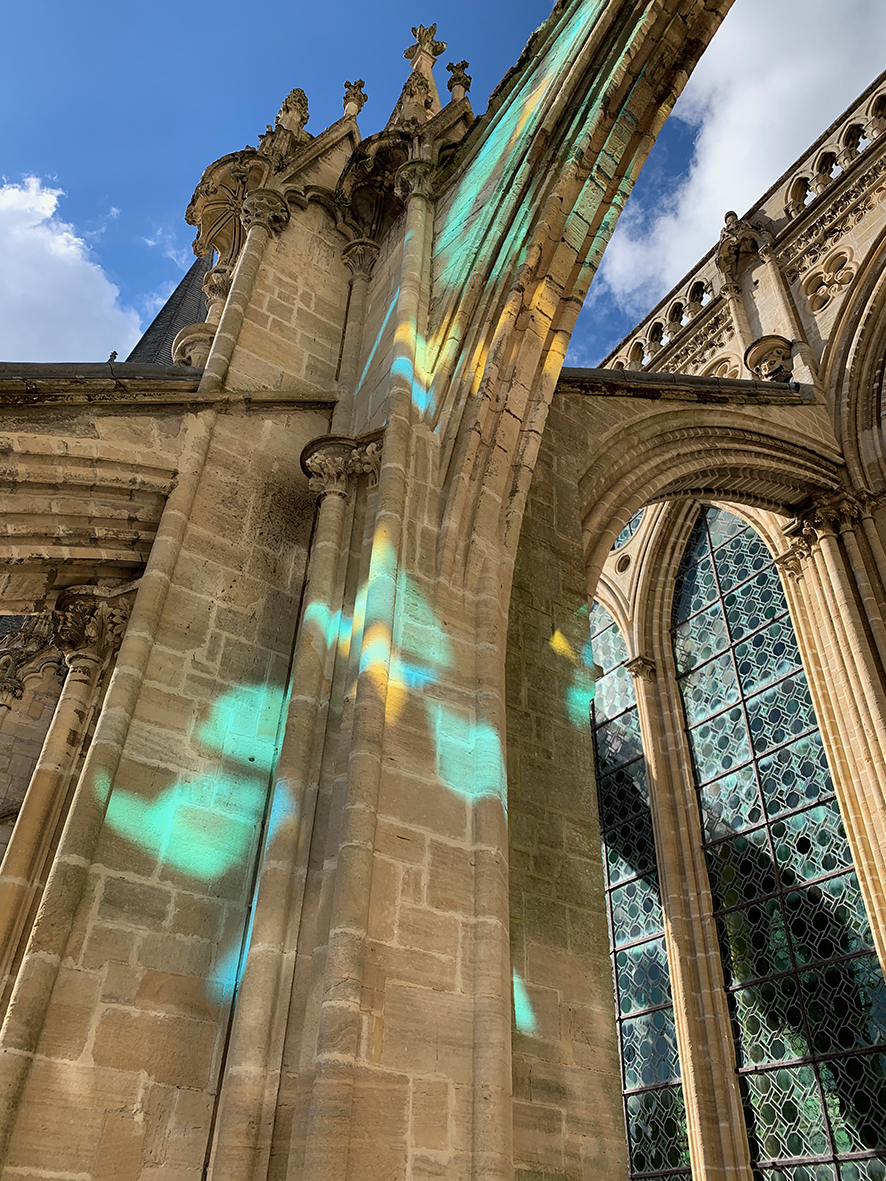
Reflections from bays 120 and122 on the cathedral arches
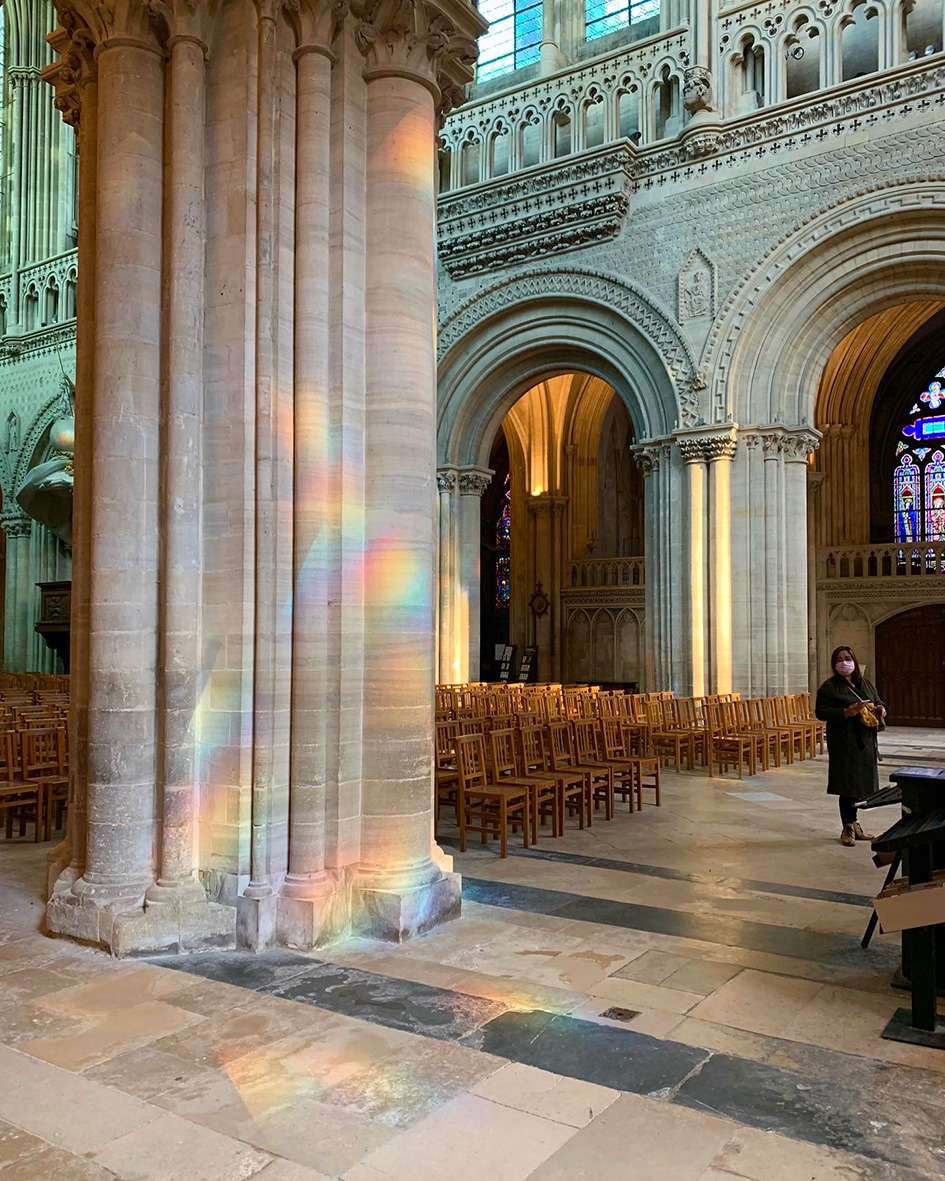
Rainbow reflections from stained-glass onto an interior pillar
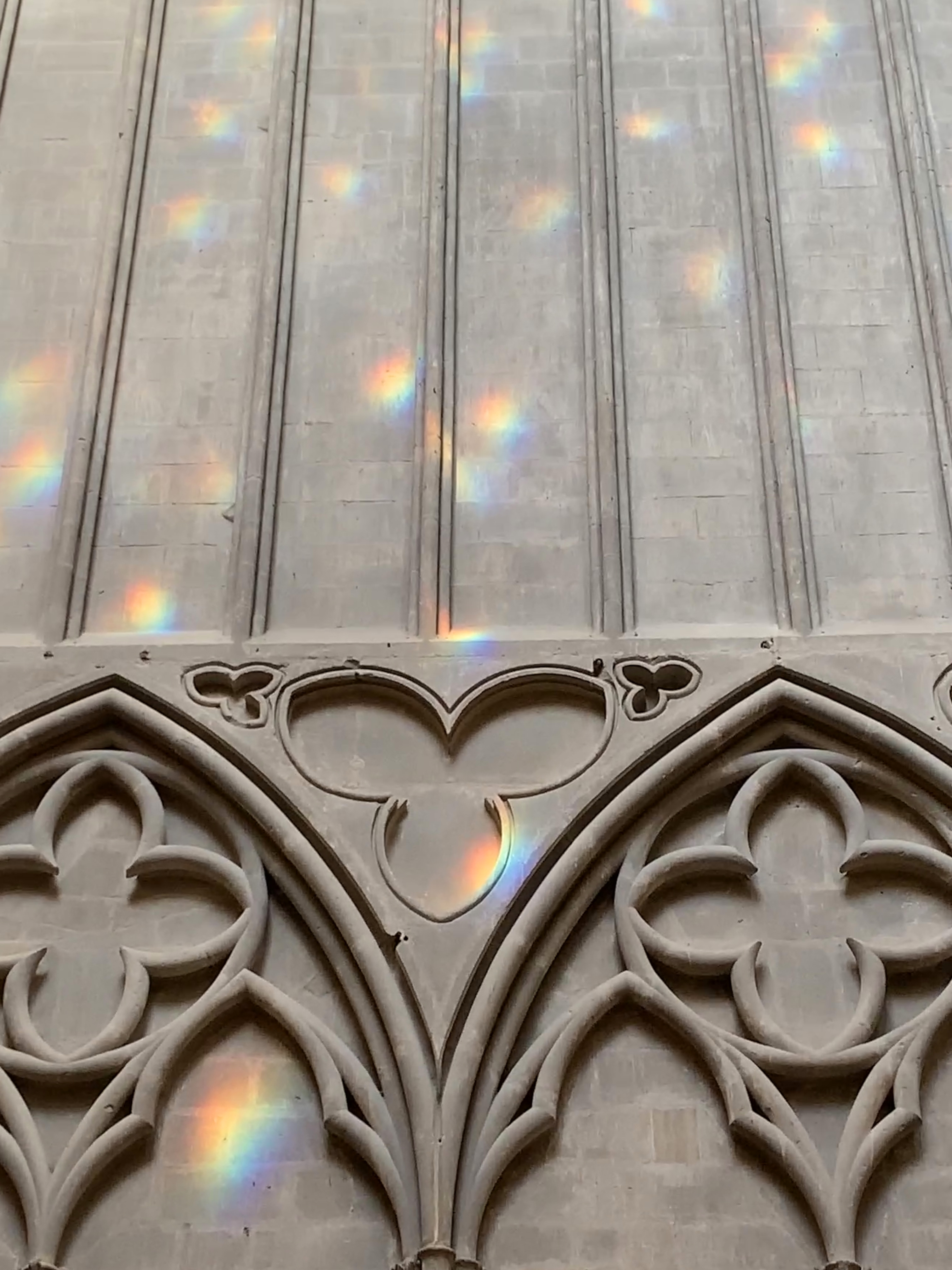
Rainbow reflections dappling an interior transept wall
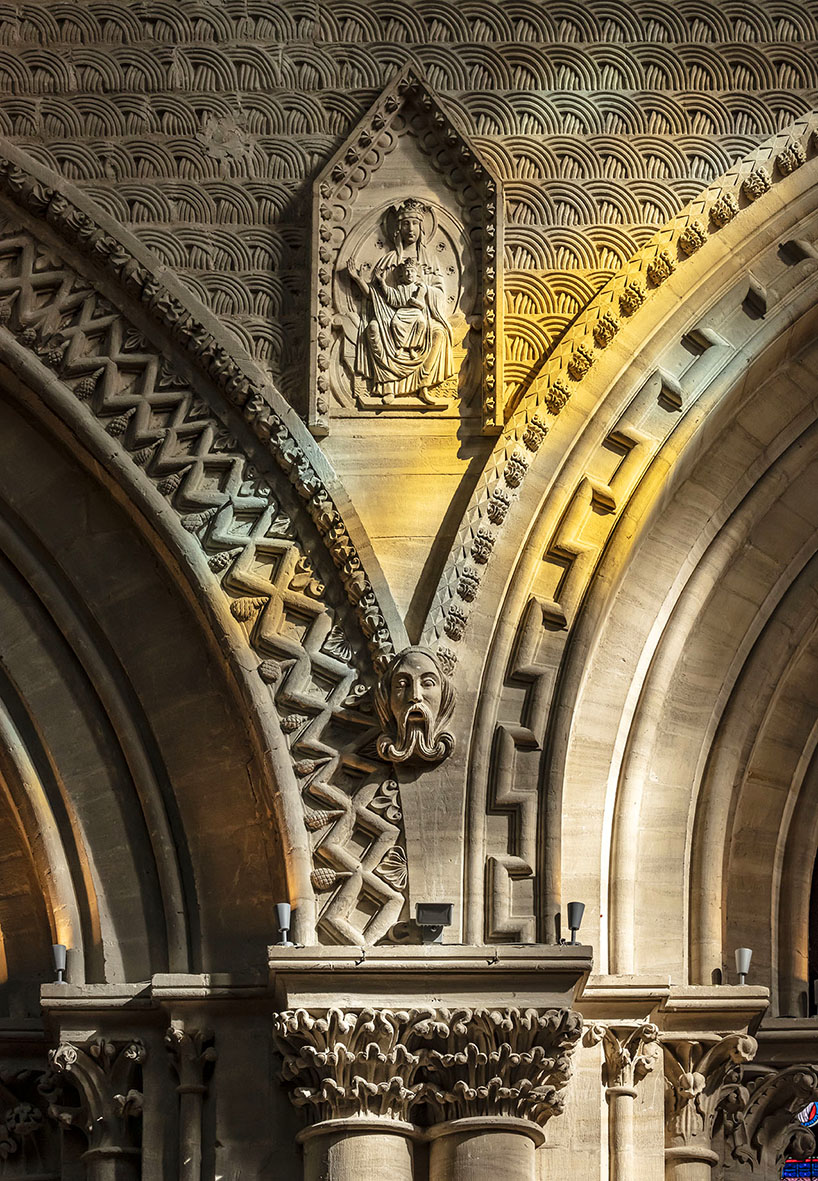
Reflected color on a nave wall
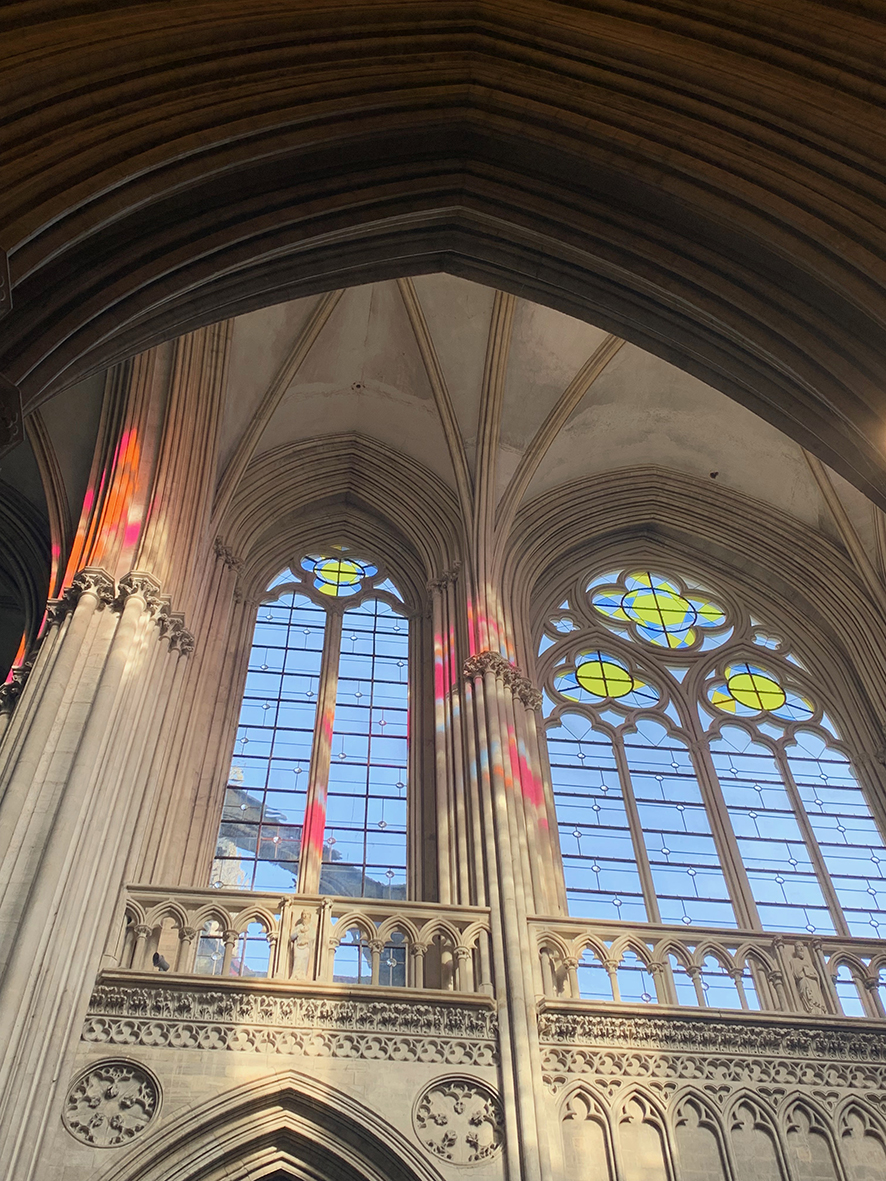
Reflected colors from bays 120 and 122 onto the interior of bays 114, 116